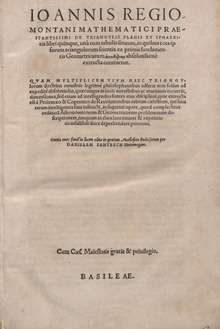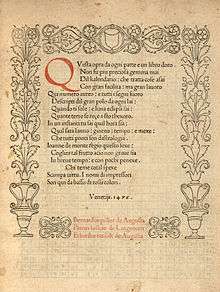Regiomontanus
| Regiomontanus | |
|---|---|
|
Regiomontanus | |
| Born |
6 June 1436 Unfinden, Holy Roman Empire, now part of Königsberg, Bavaria, Germany |
| Died |
6 July 1476 (aged 40) Rome |
| Nationality | German |
| Fields | Mathematics, astronomy, astrology |
| Alma mater |
University of Leipzig University of Vienna |
| Academic advisors |
Georg von Peuerbach Basilios Bessarion |
| Notable students | Domenico Novara da Ferrara |
Johannes Müller von Königsberg (6 June 1436 – 6 July 1476), today best known by the Latin epithet Regiomontanus, was a German mathematician, astronomer, astrologer, translator, instrument maker and Catholic bishop.
He was born in the Franconian village of Unfinden, now part of Königsberg, Bavaria — not in the more famous East-Prussian Königsberg.
He was also known as Johannes der Königsberger (Johannes of Königsberg). His writings were published under the name of Ioannes de Monte Regio, a Latinized version of his name. Both names mean "John of King's Mountain". The name "Regiomontanus" was first coined by Philipp Melanchthon in 1534, fifty-eight years after Regiomontanus' death.
Life

At eleven years of age, Regiomontanus became a student at the university in Leipzig, Saxony. In 1451 he continued his studies at Alma Mater Rudolfina, the university in Vienna, Austria. There he became a pupil and friend of Georg von Peuerbach. In 1452 he graduated with a BA and was awarded his “magister artium” (Master of Arts) at the age of 21 in 1457. It is known that he held lectures in optics and ancient literature.
Regiomontanus continued to work with Peuerbach learning and extending the then known areas of astronomy, mathematics and instrument making until Peuerbach's death in 1461.
In 1460 the papal legate Basilios Bessarion came to Vienna on a diplomatic mission. Being a humanist scholar and great fan of the mathematical sciences, Bessarion sought out Peuerbach's company. George of Trebizond who was Bessarion's philosophical rival had recently produced a new Latin translation of Ptolemy's Almagest from the Greek, which Bessarion, correctly, regarded as inaccurate and badly translated, so he asked Peuerbach to produce a new one. Peuerbach's Greek was not good enough to do a translation but he knew the Almagest intimately so instead he started work on a modernised, improved abridgement of the work. Bessarion also invited Peuerbach to become part of his household and to accompany him back to Italy when his work in Vienna was finished. Peuerbach accepted the invitation on the condition that Regiomontanus could also accompany them. However Peuerbach fell ill in 1461 and died only having completed the first six books of his abridgement of the Almagest. On his death bed Peuerbach made Regiomontanus promise to finish the book and publish it.
In 1461 Regiomontanus left Vienna with Bessarion and spent the next four years travelling around Northern Italy as a member of Bessarion's household, looking for and copying mathematical and astronomical manuscripts for Bessarion, who possessed the largest private library in Europe at the time. Regiomontanus also made the acquaintance of the leading Italian mathematicians of the age such as Giovanni Bianchini and Paolo dal Pozzo Toscanelli who had also been friends of Peuerbach during his prolonged stay in Italy more than twenty years earlier. During his time in Italy he completed Peuerbach's Almagest abridgement, Epytoma in almagesti Ptolemei. In 1464, he completed De Triangulis omnimodus. De Triangulis (On Triangles) was one of the first textbooks presenting the current state of trigonometry and included lists of questions for review of individual chapters. In it he wrote:
You who wish to study great and wonderful things, who wonder about the movement of the stars, must read these theorems about triangles. Knowing these ideas will open the door to all of astronomy and to certain geometric problems.
His work on arithmetic and algebra, Algorithmus Demonstratus, was among the first containing symbolic algebra.[1] In 1465, he built a portable sundial for Pope Paul II.
In Epytoma in almagesti Ptolemei, he critiqued the translation of Almagest by George of Trebizond, pointing out inaccuracies. Later Nicolaus Copernicus would refer to this book as an influence on his own work. He went to work for János Vitéz, archbishop of Esztergom. There he calculated extensive astronomical tables and built astronomical instruments. Later he went to Buda, and the court of Matthias Corvinus of Hungary, for whom he built an astrolabe, and where he collated Greek manuscripts for a handsome salary.[2]
In 1471 Regiomontanus moved to the Free City of Nuremberg, in Franconia, then one of the Empire's important seats of learning, publication, commerce and art, where he worked with the humanist and merchant Bernhard Walther. Here he founded the world's first scientific printing press, and in 1472 he published the first printed astronomical textbook, the Theoricae novae Planetarum of his teacher Georg von Peurbach.
In 1475 he was called to Rome to work with Pope Sixtus IV on calendar reform. Regiomontanus died of unknown causes in Rome, July 6, 1476, a month after his fortieth birthday. According to a rumor repeated by Gassendi in his Regiomontanus biography, he was assassinated by relatives of George of Trebizond whom he had criticized in his writings. More likely he died in an epidemic raging in Rome at the time.

A prolific author, Regiomontanus was internationally famous in his lifetime. Despite having completed only a quarter of what he had intended to write, he left a substantial body of work. Nicolaus Copernicus' teacher, Domenico Maria Novara da Ferrara, referred to Regiomontanus as having been his own teacher. There is speculation that Regiomontanus had arrived at a theory of heliocentrism before he died; a manuscript shows particular attention to the heliocentric theory of the Pythagorean Aristarchus, mention was also given to the motion of the earth in a letter to a friend.[3]
In 1561, Daniel Santbech compiled a collected edition of the works of Regiomontanus, De triangulis planis et sphaericis libri quinque (first published in 1533) and Compositio tabularum sinum recto, as well as Santbech's own Problematum astronomicorum et geometricorum sectiones septem. It was published in Basel by Henrich Petri and Petrus Perna.
The crater Regiomontanus on the Moon is named after him.
The comet of 1472
Regiomontanus and Bernhard Walther observed the comet of 1472. Regiomontanus tried to estimate its distance from Earth, using the angle of parallax.[lower-alpha 1] According to David A. Seargeant:[4]
In agreement with the prevailing Aristotelian theory on comets as atmospheric phenomena, he estimated its distance to be at least 8,200 miles (13,120 km) and, from this, estimated the central condensation as 26, and the entire coma as 81 miles (41.6 and 129.6 km respectively) in diameter. These values, of course, fail by orders of magnitude, but he is to be commended for this attempt at determining the physical dimensions of the comet.
Regiomontanus established Nuremberg as a centre for astronomical and mathematical studies. And, during the 15th and 16th centuries, the city was renowned for producing celestial, as well as terrestrial globes. It comes as no surprise, then, that there is an image of him in Hartmann Schedel's 1493 Nuremberg Chronicle. He is holding an astrolabe.[lower-alpha 2] Yet, although there are thirteen illustrations of comets in the 'Chronicle (from 471 to 1472), they are stylized, rather than representing the actual objects. [lower-alpha 3] The 1472 comet was visible from Christmas Day 1471 to 1 March 1472 (Julian Calendar dating), a total of 59 days.[5]
Astrology
Regiomontanus designed his own astrological house system in the 15th century, which became one of the most popular systems in Europe.[6] As a young man he cast horoscopes for important patrons, and the tables that he created while living in Hungary, his Tabulae directionum, were designed for astrology, including finding astrological houses.[7]
Criticism
Much of the material on spherical trigonometry in Regiomontanus' On Triangles was taken directly and without credit from the twelfth-century work of Jabir ibn Aflah otherwise known as Geber, as noted in the sixteenth century by Gerolamo Cardano.[8]
See also
![]() Media related to Johannes Regiomontanus at Wikimedia Commons
Media related to Johannes Regiomontanus at Wikimedia Commons
Notes
- ↑ See NASA: parallax.
- ↑ See image.
- ↑ See
References
- ↑
 Gilman, D. C.; Thurston, H. T.; Colby, F. M., eds. (1905). "Regiomontanus". New International Encyclopedia (1st ed.). New York: Dodd, Mead.
Gilman, D. C.; Thurston, H. T.; Colby, F. M., eds. (1905). "Regiomontanus". New International Encyclopedia (1st ed.). New York: Dodd, Mead. - ↑
 Clerke, Agnes Mary (1911). "Regiomontanus". In Chisholm, Hugh. Encyclopædia Britannica (11th ed.). Cambridge University Press.
Clerke, Agnes Mary (1911). "Regiomontanus". In Chisholm, Hugh. Encyclopædia Britannica (11th ed.). Cambridge University Press. - ↑ Arthur Koestler, The Sleepwalkers, Penguin Books, 1959, p. 212.
- ↑ David A. Seargeant. The Greatest Comets in History, 2009, p. 104
- ↑ Donald K. Yeomans, Jet Propulsion Laboratory: Great Comets in History, 2007.
- ↑ Lewis, James R. (1 March 2003). The Astrology Book: The Encyclopedia of Heavenly Influences. Visible Ink Press. p. 574. ISBN 978-1-57859-144-2. Retrieved 4 August 2012.
- ↑ Mosley, Adam (1999). "Regiomontanus and Astrology". Cambridge University: History and Philosophy of Science Department. Retrieved 2013-06-12.
- ↑ Victor J. Katz, ed. (2007). The mathematics of Egypt, Mesopotamia, China, India, and Islam: a sourcebook. Princeton University Press. ISBN 978-0-691-11485-9., p.4
Further reading
- Irmela Bues, Johannes Regiomontanus (1436–1476). In: Fränkische Lebensbilder 11. Neustadt/Aisch 1984, pp. 28–43
- Rudolf Mett: Regiomontanus. Wegbereiter des neuen Weltbildes. Teubner / Vieweg, Stuttgart / Leipzig 1996, ISBN 3-8154-2510-7
- Helmuth Gericke: Mathematik im Abendland: Von den römischen Feldmessern bis zu Descartes. Springer-Verlag, Berlin 1990, ISBN 3-540-51206-3
- Günther Harmann (Hrsg.): Regiomontanus-Studien. (= Österreichische Akademie der Wissenschaften, Philosophisch-historische Klasse, Sitzungsberichte, Bd. 364; Veröffentlichungen der Kommission für Geschichte der Mathematik, Naturwissenschaften und Medizin, volumes 28–30), Vienna 1980. ISBN 3-7001-0339-5
- Samuel Eliot Morison, Christopher Columbus, Mariner, Boston, Little, Brown and Company, 1955.
- Ralf Kern: Wissenschaftliche Instrumente in ihrer Zeit/Band 1. Vom Astrolab zum mathematischen Besteck. Köln, 2010. ISBN 978-3-86560-865-9
External links
| Wikimedia Commons has media related to Johannes Regiomontanus. |
- "Regiomontanus". Biographisch-Bibliographisches Kirchenlexikon (BBKL) (in German).
- Günther (1885), "Johannes Müller Regiomontanus", Allgemeine Deutsche Biographie (ADB) (in German), 22, Leipzig: Duncker & Humblot, pp. 564–581
- Folkerts, Menso ; Kühne, Andreas (1955), "Regiomontan(us)", Neue Deutsche Biographie (NDB) (in German), 2, Berlin: Duncker & Humblot, pp. 270–271
- Adam Mosley, Regiomontanus Biography, web site at the Department of History and Philosophy of Science of the University of Cambridge (1999).
- O'Connor, John J.; Robertson, Edmund F., "Regiomontanus", MacTutor History of Mathematics archive, University of St Andrews.
- Electronic facsimile-editions of the rare book collection at the Vienna Institute of Astronomy
- Regiomontanus and Calendar Reform
- Polybiblio: Regiomontanus, Johannes/Santbech, Daniel, ed. De Triangulis Planis et Sphaericis libri quinque. Basel Henrich Petri & Petrus Perna 1561
- Engl. Biographie bei MacTutor
- Joannes Regiomontanus: Calendarium, Venedig 1485, Digitalisat
- Beitrag bei „Astronomie in Nürnberg“
- Digitalisierte Werke von Regiomontanus — SICD der Universitäten von Strasbourg
 "Regiomontanus". The American Cyclopædia. 1879.
"Regiomontanus". The American Cyclopædia. 1879.
 "Regiomontanus". Encyclopædia Britannica. 20 (9th ed.). 1886.
"Regiomontanus". Encyclopædia Britannica. 20 (9th ed.). 1886.- Regiomontanus at the Mathematics Genealogy Project
- Online Galleries, History of Science Collections, University of Oklahoma Libraries High resolution images of works by and/or portraits of Regiomontanus in .jpg and .tiff format.
- Regiomontanus, Joannes, 1436-1476. Calendarium. Venice, Bernhard Maler Pictor, Erhard Ratdolt, Peter Löslein, 1476. [32] leaves. woodcuts: border, diagrs. (1 movable, 1 with brass pointer) 29.6 cm. (4to). From the Lessing J. Rosenwald Collection in the Rare Book and Special Collections Division at the Library of Congress
- Doctissimi viri et mathematicarum disciplinarum eximii professoris Ioannis de Regio Monte De triangvlis omnímodis libri qvinqve From the Rare Book and Special Collection Division at the Library of Congress
- Regiomontanus' Defensio Theonis digital edition (scans and transcription)

.jpg)
